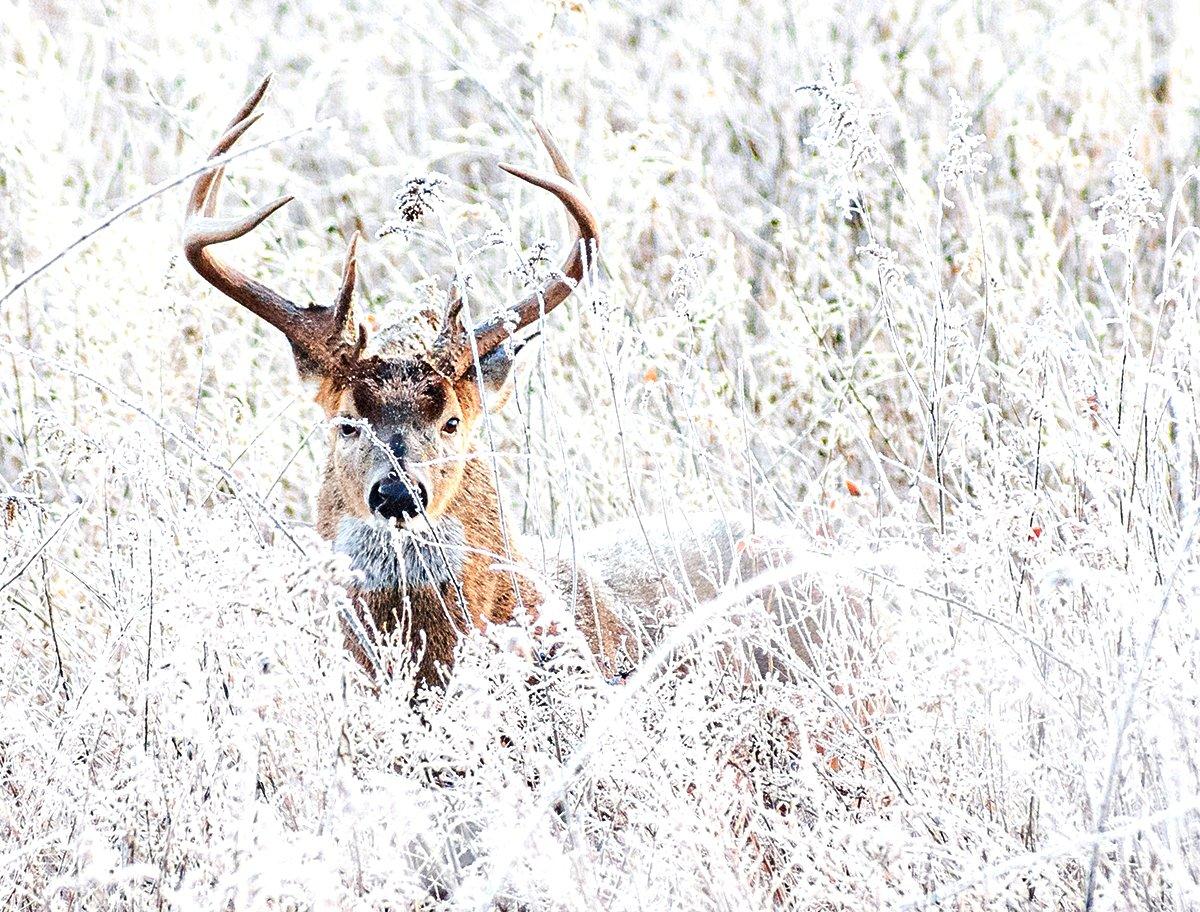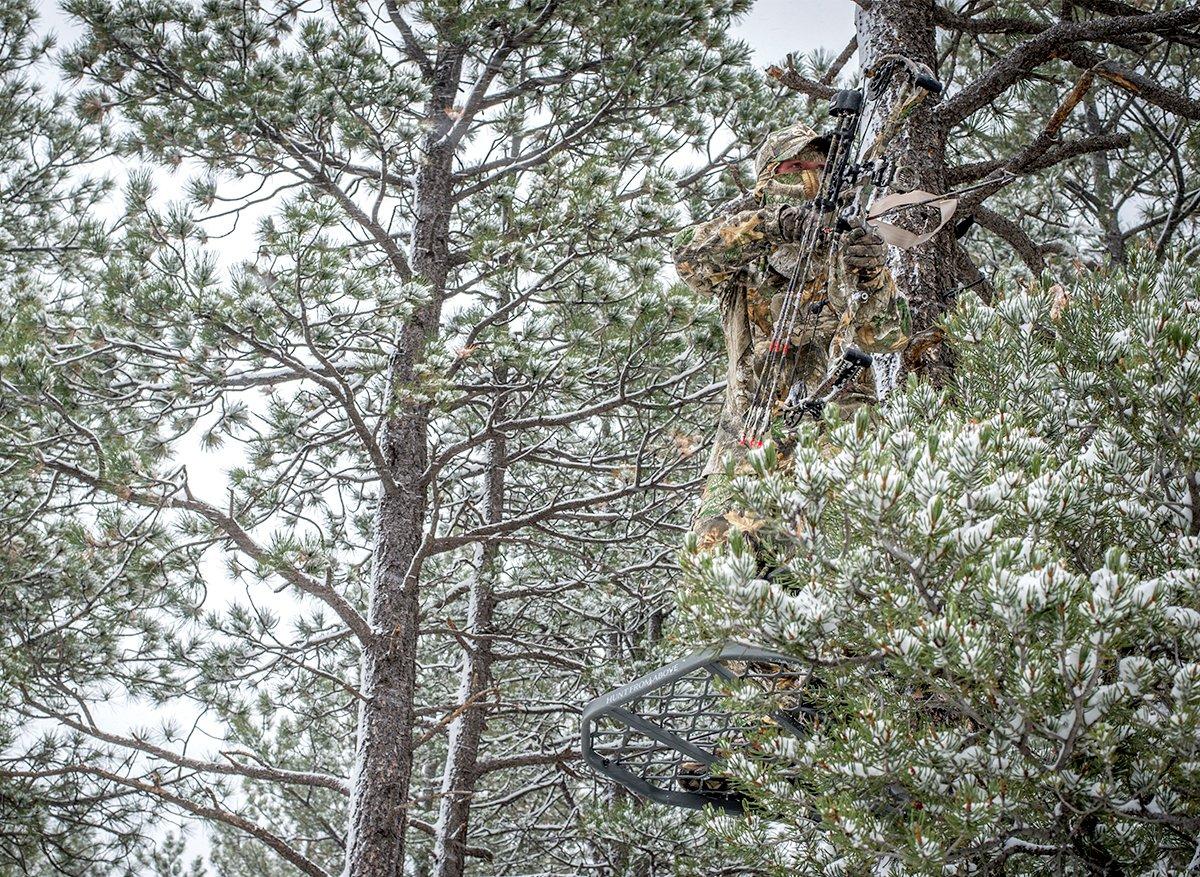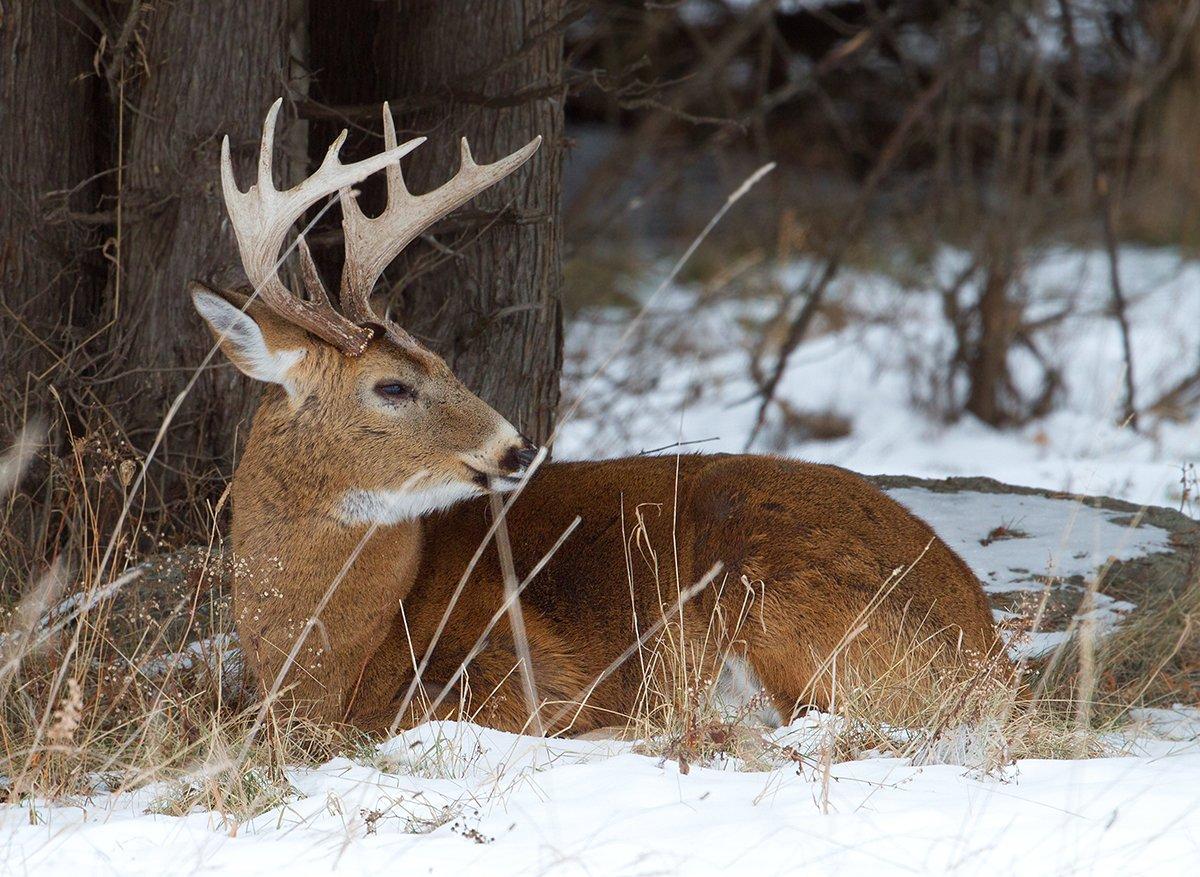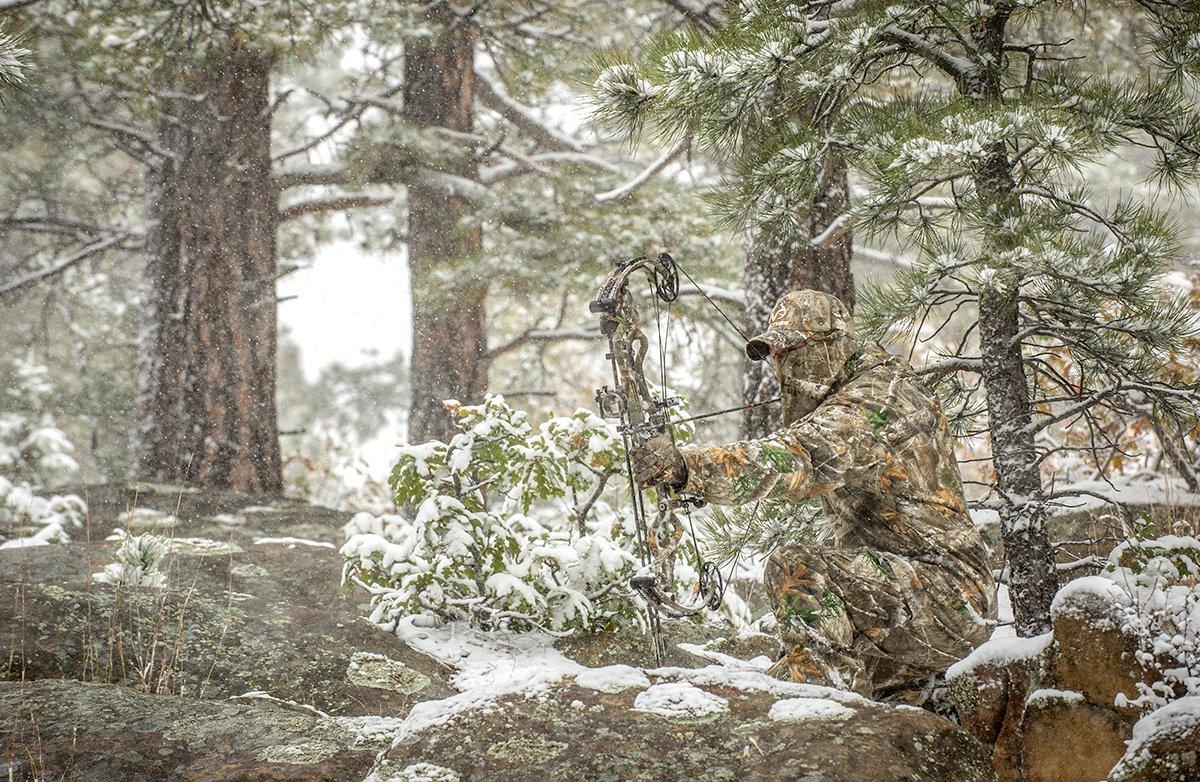It's not over yet. Bundle up, keep grinding, and use this advice to punch your last buck tag
Face it, if you haven't tagged out by now it's going to be tough. The first and second ruts are history in most places. Other hunters have killed the easy bucks and spooked the survivors into hiding. You've got two options. Eat tag soup and pack it in until next fall, or bundle up, hang in the woods and try to pull an 8-pointer out of your stocking cap. I reckon you'll go for the latter, so I pulled together these tips to help you score at the tail-end of the season.
1. Grains and Greens
Thin and weary after weeks of rutting, does and bucks have got to eat, especially when it's cold and snowy. Corn and soybeans are top attractants, as are late-season plots of turnips and brassicas. In this environment, access to your stand is critical. Go in early and try to sneak down a field edge or through a ditch or creek without one deer seeing you and flagging off. The less pressure you put on a food source, the earlier a mature buck is likely to show up in the evening before dark.
2. Big-Woods Mast
If you hunt big public woods with no crops or plots for miles, like the Allegheny National Forest in New York or the George Washington in Virginia, search for leftover mast or a logged area with browse. If you can find a hemlock or pine swamp with oak ridges above it on either side, or a relatively recent clear-cut within a quarter-mile or so, you'll find deer, says veteran New York hunter Dave Streb.
3. When It's Cold…
In brutal conditions, Northern deer gravitate to stands of spruce, pine, and other conifers, which provide thermal cover from wind and snow. In there, the animals are less active, which allows them to eat less and save energy. Snow-track deer to a thicket of conifers, then get the wind right, set up on the edge, and watch for a buck standing up to stretch or stick his neck out for a bite.
4. Track a Buck
You cut large tracks in snow — buck or old doe? A mature buck's stride is noticeably longer than a doe's, and his fat front and back prints are linked with drag marks.
5. If It's Hot…
Daytime temperatures in the 50s or 60s are not unheard of in late December and even January these days, and this can turn your late-season strategy on end. I typically prefer to hunt in the afternoons during the last week, but when it is unseasonably warm, dark, chilly mornings tend to be better. Some bucks that moved and fed at night linger around field edges for the first hour of daylight, so be there.
(Don't Miss: Don't Let a Dead Deer Kill You)
6. Sneak a Funnel
One year, Realtree Pro Don Kisky hunted Old Double Drop for two weeks near a field of cut corn on his Iowa farm, but the buck never showed up before dark. Double Drop was smart but so was Don. Second to last day of season, early in the afternoon, Kisky put the wind in his face and sneaked 200 yards back into a narrow, CRP-choked ravine that funneled off the field. He found a patch of cedars with a view and set up on the ground. At twilight he looked up and shuddered — Double Drop was walking to him! Don's muzzleloader belched smoke and his season was capped in spectacular fashion. Lesson: Don't get overly caught up in hunting over food. Some old, wired bucks hang up back in cover until dark, regardless of how cold, snowy, and miserable it is. Often it pays to play the wind, sneak back into cover where you think a big deer stages or beds, and go for an ambush.
7. Think Small
Fifty, 20, 10 acres … A small property with thick, diverse cover can hold a giant whitetail or two in late December or January. The key is not to pressure the spot too hard if at all early in the season. Hunt other properties if you can during the November rut, and let hunters on surrounding lands push deer into your little sanctuary. Now is the time to move in. Set a stand or blind and hunt it out.
8. Tough It Out
Set a treestand near a large blackberry thicket, on the edge of a clear-cut or any similar spot with some green browse left for deer. If you have the physical and mental stamina, hang in that stand all day. The last week of season, bucks feed mostly in the evening and sometimes at dawn. But since a big deer might feel somewhat safe and hidden in a thicket, especially a secluded one deep in the woods, he might get up to stretch and browse buds and stems at 11:00 a.m., noon, or 2:00 p.m. You might tag out if you tough it out.
9. The 2-Man Nudge
When deer are holed up tight and bucks are nocturnal, try a soft, sneaky push. Post a buddy in a treestand or on a hill on the downwind edge of a funnel with thick cover. With the wind at your back, walk and zigzag slowly through that draw or thicket in hopes of nudging a buck to the waiting shooter.
10. Doe-Day Sit
One January morning in Virginia, I hunted a spot where I hadn't seen a buck in over three weeks, but I was hopeful. Pretty soon I heard the whine of 4-wheelers. The sun came up and sporadic gunfire erupted on surrounding lands. I gripped my .270 a little tighter. A half-hour later, four does flew over a ridge and scrambled down into the honeysuckle draw I was watching. When the 8-pointer crested the rise a few minutes later and did the same, I pulled the trigger. He was not a monster, but fat as beef, and his venison was delicious.
The day a special antlerless or doe day opens, often during the last few days of gun season in many areas, be out there. The hoard of people who hunted opening week and the rut will be back in hopes of whacking a doe for the freezer. The hunters will be bolder and more aggressive now. After spending the first hour of the morning on stand, many of them will climb down, meet up, and start beating the bushes on doe drives. You stay put in a stand with a good view of a major security thicket. There's a decent chance the doe hunters will scare a buck toward you. If not, there's a great chance they'll push a fat doe your way. Take the shot and eat well for a year if you've got an antlerless tag.
(Don't Miss: Ghost Busters: What to Do When Your Buck Disappears)
11. Shh! Quiet Now
In cold, still woods, boots crunching snow or cracking a stick, or your bow or gun stock inadvertently knocking against a frozen steel platform, sounds like a bomb going off to nearby deer that are ultra-spooky in the late season. Go slow and watch your step as you walk to a stand or blind; climb up or in and organize your gear as quietly as possible.
12. Confirm Cold Zero
A rifle zeroed in hot, steamy August is apt to shoot a few inches off when the air is dry and the barrel gets cold. Leave your gun outside for a few hours on a cold winter day, and then go to a range and fire two or three test shots. Check the bullets' point of impact and tweak your scope if necessary.
13. Strap In, Stay Limber
It's an old-school piece of gear, but I wear an extra-long arm guard that runs along the inside of my forearm and up onto my bicep when bowhunting the last weeks. I cinch it tight, so I don't worry about a bulky coat sleeve grabbing the bowstring on a shot. On stand, I look around every 30 minutes to make sure no deer are coming. I draw my bow and let down to warm and stretch my shoulder and arm muscles.
14. Far-North Cover
Biologists in the Upper Midwest and New England say that 5- to 40-acre conifer stands or swamps are good places to find whitetails in winter. Size-wise, there's enough good shelter for some deer, but not too much cover for too many deer, which can quickly over-browse and degrade a thermal cover. Check aerials on an app or map for covers like that.
15. South-Facing Cover
In states like Illinois, Iowa, and Kansas, where it gets darn cold but not as bitter as in Minnesota or New England, whitetails seek out different thermal covers. Many deer bed in south- or east-facing ravines or on slopes where cedars are spotty but not too thick, and where daytime sunrays warm them up. Scout for those spots.
(Don't Miss: Mother and Son Shoot Big Locked-Up Bucks)
16. Late Public-Land Rut
Scientists at Mississippi State's Deer Lab found that in late December or January, hunters can often experience good rutting action on a WMA or national forest where does far outnumber bucks. The biologists say that on lands where the buck-to-doe ratio is out of whack, there aren't enough bucks to breed the adult does during the primary rut in November or early December, and a good number of missed does re-cycle back into heat four or five weeks later. Since there aren't as many hot-to-trot does then, the estrus ones draw the bucks and may even concentrate them in certain areas. The MSU study found that bucks 2.5 years and older do most of the late breeding, so you might yet shoot a good buck on public land.
17. Hunt the Edges
Closely watch the edges of secluded pine, cedar, or honeysuckle thickets. Jittery bucks sneak along the fringes between bedding and feeding areas, moving in little places where they haven't been spooked earlier in the season.
18. Find a Buck Hole
Now is the time to scout for a hidden buck hole. It might be a 2-acre beaver swamp near a gravel road or an overgrown hog lot behind a dilapidated barn. You get the idea. Check for a buck hiding out in a spot you and other hunters missed earlier in the season.
19. Ground Ambush
Moving in for a quick-strike ground attack is a good tactic, but be smart. If you try to pop up a blind on a field edge or in bare woods one day, it's about guaranteed to freak out every super-spooky deer that comes along and sees it. Go with a low-profile natural blind instead. Stack just enough cedar boughs, sticks and brush to break your outline and cover your moves as you sit against a tree or fence post and hunt.
20. Hunt Low
A howling north wind woke me an hour before the alarm chimed. I lay in my toasty bag and chose my stand — a ladder deep in a creek bottom that was protected by a south-facing bluff. As I climbed into the stand an hour later the wind thundered like a freight train up on the hills, but it was still, quiet, and quite warm in the hidden bottom.
The sun rose and I started seeing deer. Ten does and yearlings and a couple small bucks came and went. At 10:00 I ate lunch and drank a cup of coffee. At 11:00 a thick 8-pointer strolled by, and I whacked him. The wind was still howling up on the hills as I gutted the buck and began the hard drag out.
Lesson: Hang a couple of stands down in draws and bottoms near the base of a ridge or bluff that blocks a northwest wind. When a high wind howls, deer move best in a low, sheltered area. Be there waiting.
(Don't Miss: How to Can Deer Meat)














